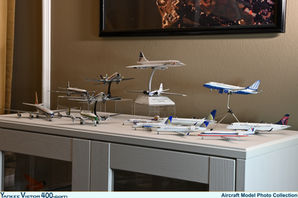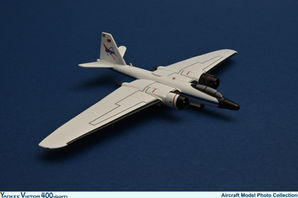Versus Series Vol. 11: Southwest Airlines 727-200 GeminiJets vs. Aeroclassics
- Jorge A. Zajia
- Mar 22, 2024
- 4 min read
Updated: Mar 29, 2024
To highlight their exclusivity in aerospace circles, it has been said that there were fewer Concorde pilots than astronauts during the years the supersonic airliner was active. But very little is said about another group of aerospace professionals that was even more exclusive: The Flight Engineers of Southwest Airlines.
Southwest has - almost - always been a 737-only operator. In fact, they have consistently been the largest 737 operator in the world for several years, and have operated more than 1200 aircraft of the type (not at once). The fleet uniformity has been one of the many factors that have contributed to Southwest's success. But during two different periods in 1979 and the mid-1980s a different type of Boeing aircraft briefly wore the Southwest livery, the 727-200. The 737 is designed and certified to be flown by two pilots, whereas the 727 requires a third person in the cockpit: a Flight Engineer. This is why being a Southwest Flight Engineer was such a distinction among the flight crews of well-established airlines.
Southwest operated a total of seven 727-200s. The first one was a 727-291 originally delivered to Frontier in 1968 as N7276F, and acquired by Braniff in 1972, which re-registered it as N406BN. Braniff leased the jet to Southwest in 1979 as part of an anti-trust settlement. Yeah, Southwest earned itself a few enemies in the Dallas area during the seventies.
N406BN was used by Southwest for 10 months on what was their busiest route at the time: Dallas-Love Field to Houston-Hobby. Later, in the mid-eighties, the 727-200 joined the Southwest ranks once more. This time, six 727-227s leased from People Express were used on new longer flights for which the 737-200 did not have the legs. These airplanes were sort of a stopgap while the airline waited for the more capable 737-300.
Okay, so that was the aviation history part of this article. Now let's move on to the airplane model collector bit.
Here I have two -tiny- 1:400 scale replicas of N406BN, Southwest's first 727-200. The first one was produced by a brand called Aeroclassics in 2009, and quickly sold out. Recently, another brand, the more mainstream GeminiJets, released N406BN in 1:400 scale again.

Since the two models attempt to replicate the same airplane in 1:400 scale, they should be identical, right? Not quite, not even close in fact. You see, scale models are works of art, so when two model brands attempt to replicate the same airplane, we get two different artistic representations of the same subject. Just like artists, diecast airplane model brands have their unique signatures.
Let's look at photos of the two models, and compare them. Is one better than the other? Can we learn any peculiarities about this aircraft through these scale models? Can you spot all the differences!?
Contestant Number 1 | Contestant Number 2 |
Airline: Southwest Airlines | Airline: Southwest Airlines |
Aircraft: Boeing 727-291 | Aircraft: Boeing 727-291 |
Reg: N406BN | Reg: N406BN |
Model Brand: Aeroclassics | Model Brand: GeminiJets |
Scale: 1/400 | Scale: 1/400 |
Release Date: 2009 | Release Date: Early 2024 |
Southwest Airlines 727 Aeroclassics vs. GeminiJets













Real Deal
Images linked to source:
Thoughts
Much has been said about the accuracy of the colors of both models. N406BN was notorious for wearing a slightly greener version of Southwest mustard color that differentiated it from the rest of the 737 fleet. Aeroclassics seems to have exaggerated this a little bit. It has been pointed out that GeminiJets went with the standard Southwest Mustard Rocket colors worn by current 737s on their representation of N406BN. To me, that seems to be the case.
The color issue is not that big of a deal to me, as the real airplane could look like either model in real life depending on the lighting.
A bigger issue that I had not noticed until I started comparing the two models is that Aeroclassics omitted the two most forward passenger windows on the port side, and placed the Southwest titles too far back, aligned with the titles on the starboard side. In reality, the Southwest titles were justified with the 1L and 1R doors, which are staggered. GeminiJets got it right.
One last thing on the livery artwork, Aeroclassics depicted a grey access panel below the reg. on the port side, which is not present on the real aircraft.

The GeminiJets model enjoys antennas (one at least) and modern printed details. I also like the overall shape of Gemini's 727 better, especially the nose section. Two things I prefer about the Aeroclassics example are the shape of the number 2 engine intake and the size of the nosewheel tires. Ironically, the GJ 727-200 mold used to be comparable to the Aeroclassics one in those areas, but things have evolved for the worse. As you can see in the photo below, older GJ 727-200 nosewheel tires were less detailed but better sized. Also, while the horizontal stabilizer seam on the tail has been eliminated, its overall shape suffered, including the leading edge of the vertical stabilizer and the characteristic tail engine (#2) intake.

So, is one of the two representations of N406BN better than the other? That's for you to decide! I like the GeminiJets "refreshed" version better, but the Aeroclassics one remains a valid option, I think.
Special thanks to George Hamlin for allowing the use of his photos of N406BN in this article.




























